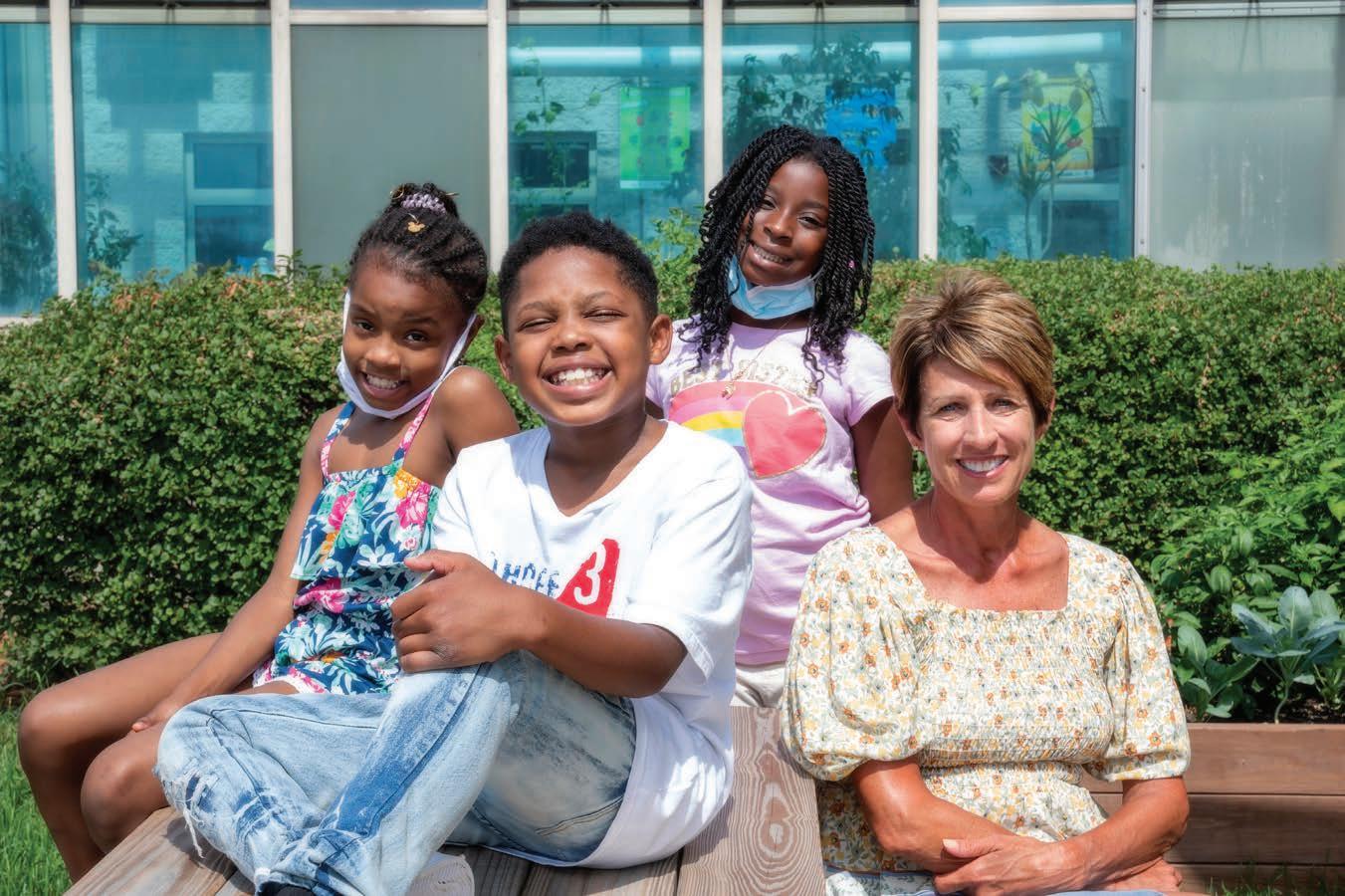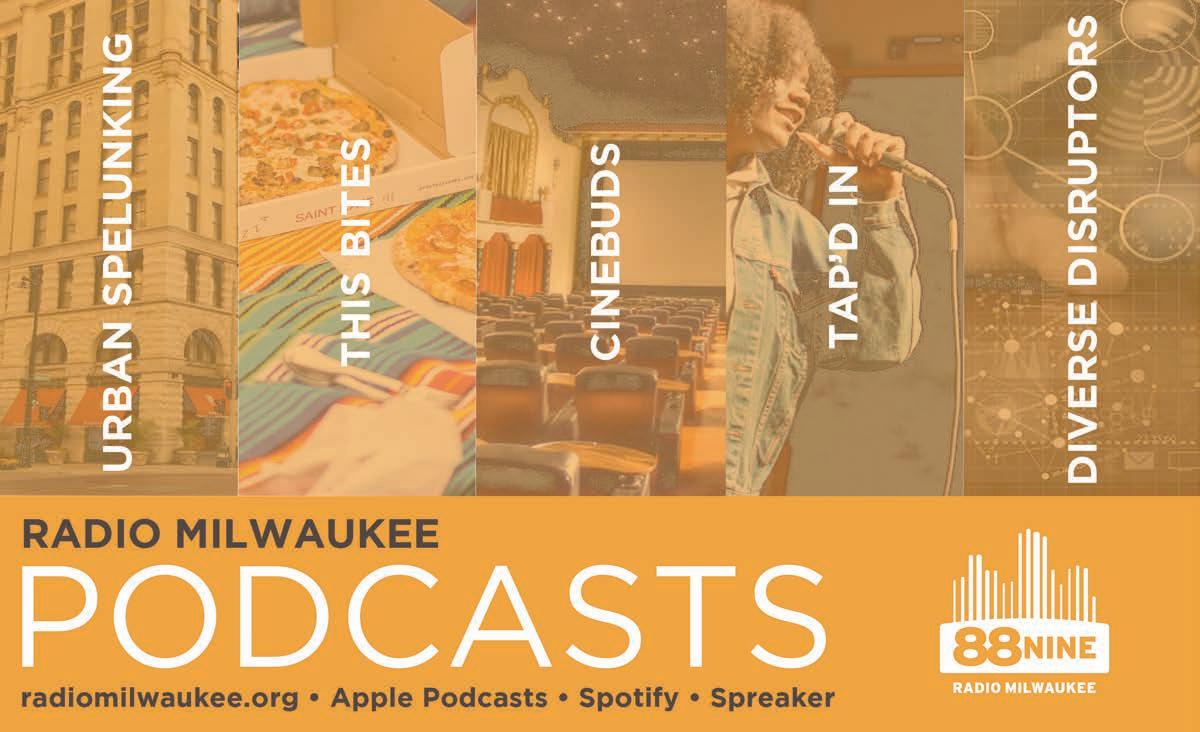
7 minute read
SHARP Literacy Serves Students in Urban Schools — Off the Cuff

SHARP Literacy Serves Students in Urban Schools
PRESIDENT & CEO LYNDA KOHLER ON THE VALUE OF INTERACTIVE EDUCATION
BY TOM JENZ

In the middle of an urban food desert, on 64th and Silver Spring, SHARP Literacy has collaborated with community partners to restore and modernize a once-idle greenhouse at Silver Spring Neighborhood Center and Browning Elementary School. The greenhouse has been transformed into an interactive, sciencefocused learning curriculum for students from K-3 to 5th grade.
Lynda Kohler is President & CEO of SHARP Literacy. She also serves on VISIT Milwaukee’s board and UW-La Crosse Alumni board. In the past, she has served on the boards of Make-AWish, MACC Fund and Children’s Hospital of Wisconsin. She has an infectious personality—energetic, enthusiastic and infused with a love for teaching children.
You’ve had a long successful career, and now you are head of a thriving educational nonprofit organization. Tell me about your path to success.
I grew up in Kenosha. My dad was a letter carrier. He believed in the work ethic, never complain, do your job regardless of setbacks. I learned from him at an early age. I graduated from Kenosha Bradford High School. I was an athlete, and I went to UW-LaCrosse and ran track for all four years. I majored in recreation therapy, and that took me to my first job as an intern at Kimberly Clark where I helped the staff stay fit at the employee health center. This was at the start of the corporate fitness trend.
How did you end up in Milwaukee?
I graduated in 1983, and I moved to Milwaukee as a customer service representative at Midwest Express Airlines. Eventually, I became the Passenger Service Manager and oversaw all the customer service reps. I later lived in Boston and Kansas City in management positions. Then, I ended up back in Milwaukee as the executive overseeing all of the sales: corporate, charter, conventions, and other customer groups.
You had a successful corporate career for 25 years with the same company, but then you shifted into the nonprofit arena. How did that happen?
I’d sat on a number of nonprofit boards like Children’s Hospital of Wisconsin. After Midwest was bought out in 2008, I was hired as President of the Ronald McDonald House and worked there for four and a half years. We served the parents of the children cared for at Children’s Hospital. But I wanted to work directly with children, and in 2012 I was recruited to be President of SHARP Literacy after the founder, Marlene Doerr Kreilkamp, retired. I fell in love with Sharp’s mission.
What exactly is the mission of SHARP Literacy?
Basically, it’s hands-on learning through participation. SHARP partners with educators to foster a love of learning. We advance children’s futures through innovative STEAM-based experiences

and programs. We are a year-round, in-school program, though we also have our summer and after-school programs. We deliver our curriculum to K3 through 5 students in public, charter and choice elementary schools. There is no charge for our programs. Our corporate and private donors understand this and the impact we make on these children.
How does the curriculum work and how does it differ from traditional methods?
We have part-time educators that go into the schools and support teachers with our educational programs. We develop all of our curricula in-house and create and produce our own We Love to Learn books. For example, our second-grade curriculum is all about weather, water and the environment. That book focuses on the salmon life cycle and teaches students about the weather and water cycles.
During the school year, for all our programs, we have four to 18 classroom workshops. We also include educational tours, and those have a big impact on learning. For instance, our second graders will spend interactive time at Discovery World with its educators. These tours take place on Mondays when Discovery World is closed. In that way, the students feel special and aren’t distracted. It’s the experiential learning component of SHARP’s program.
The way I understand it, your curriculum is not only learning about the environment but also art related.
We incorporate the concept of STEAM: science, technology, engineering, art and math. We put an emphasis on the A, on art. Everything we do has an art component. We’ve found that children connect to art, to the visual process in learning. We like to be creatively hands-on, sparking their curiosity. In other words, we make learning fun. SHARP also has a comprehensive Summer Learning Program. This summer, we’ve had over 800 students at 26 different sites, almost every community learning center in the city and also nine Milwaukee Public Schools summer learning programs.
Right now, we are sitting in a public school, Browning Elementary, but you also work with all different kinds of schools.
That’s right. We’re in MPS, charter and choice schools, as well as Waukesha County schools. Eighty-one percent of our students are of color, half African American, half Latinx—and most come from economically disadvantaged homes. We have a very strong presence in both South and North side elementary schools. Our educational programs are provided free of charge. Internally, they cost approximately $163 per student which includes books, workshops, staff time and educational tours. In 2021/2022, we’ll serve close to 9,000 students in our school year, After-School and Summer Learning programs.
One of your most successful programs takes place here at Browning Elementary and the Silver Spring Neighborhood Center. You call it the Urban Greenhouse Revitalization Project.
We’ve partnered with the MPS Browning Elementary School for about seven years. There was an old vacant greenhouse connected to this building. In 2014, we published an urban agriculture book, There Grows the Neighborhood: Agriculture in the City, for our third graders. I thought that providing our students the opportunity to grow plants in the greenhouse would be a great hands-on learning experience. We restored and revitalized the greenhouse, and now use it year-round.
How did the greenhouse renovation come about?
We collaborated with numerous community partners to bring this project to life. Johnson Controls, Milwaukee School of Engineering, Silver Spring Neighborhood Center, MPS, PortFish, Keep Greater Milwaukee Beautiful and Teens Grow Greens all played a role. We partnered with MSOE and their honor students on the development of a solar dehydrator, the largest in Wisconsin. We added greenhouse aquaponics and hydroponics systems, installed a video monitoring system, LED grow lights, a composting station, and three raised garden beds where students grow and harvest food.
With an aquaponics system combining fish and plants, the students to learn about the life cycle components. The fish waste provides the nutrients for the plants to grow, and then the kids tend to the plants and later harvest them. Over the winter months, we have starter plants for the students to learn about the growing process. During SHARP’s Summer Learning Program, they transplant these seedlings into three garden beds outside the greenhouse. It’s really hands-on for the students—they do the digging, pull the weeds, water the plants, and tend to them. They can actually grow 25 pounds of produce in about a month’s time—fruits and vegetables like strawberries, lettuce, zucchini, tomatoes, onions, collard greens and beets. We want the kids to take pride in growing things, a sense of ownership.
In other words, you’re giving grade school students the chance to not only grow their own vegetables but harvest, produce and eat them.
That’s true. Through SHARP’s curriculum, students learn about life cycles of plants, nutrition, and urban gardening in a food desert—from planting to harvesting. It’s quite wonderful. For some students, this is the first time they’ve picked a tomato or pulled a carrot out of the ground. Most of these students live in urban environments and have never worked in a garden. We also teach the kids about eating healthy and show them that vegetables can taste good. For instance, we’ve baked zucchini bread and muffins, and even prepared homemade salsa. Students are encouraged to take vegetables and herbs home to their families. We even send home recipes. Extra produce from the garden is also donated the Silver Spring Neighborhood Center Food Pantry serving the local community. SHARP’s Greenhouse program teaches students that in urban gardens, they can plant, grow and harvest their own nutritional food.
Maybe you could summarize the Urban Greenhouse Revitalization Center program in a few sentences.
The revitalization program gives these elementary school kids experiences and opportunities to learn about urban agriculture in a unique and hands-on way. What we teach students in the greenhouse environment, they can’t learn by simply reading a book.
Your students come from urban and disadvantaged backgrounds. They live in food deserts, mostly concrete and blacktop. You are educating them to learn about the basic cycle of life in the overall environment.
Our students are basically learning about good, nutritional foods, and hopefully that knowledge will make them healthier as they grow up.
Tom Jenz is a Milwaukee writer and photographer. For his column, Central City Stories, visit shepherdexpress.com.











